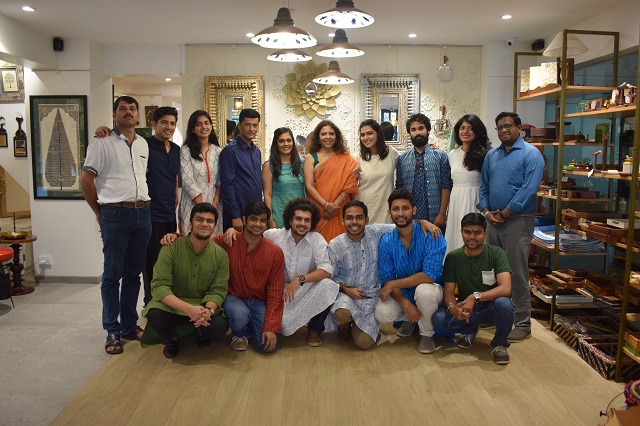
Baaya Design hosts an exclusive range of home accessories and offers stunning interior styling solutions. They believe in an elegant fusion of traditional crafts, contemporary aesthetics and modern functionality for a rich experience. Each of their product is handcrafted by skilled craftsmen and narrates the story of a practice perfected over centuries and passed down over generations. The founders of Baaya Design are Mrs Shibani Dasgupta Jain (CEO and Founder) – Mr Vipul Jain (Partner).
About Shibani Jain
Shibani is an alumni from NID Ahmedabad. She worked with a reknowned digital media company right from its start-up stage to head the Design function. Later the entrepreneurship bug caught her and she founded Baaya Design. Baaya has a mission to rejuvenate indigenous art and craft by contemporising products and offering bespoke solutions for modern day spaces. With an iconic store in Raghuvanshi Mills, and a Design Studio for customised projects, Baaya has emerged as the “go-to” place for handmade, well crafted art and decor solutions and gifts.
About Vipul Jain
Vipul is an alumni from IITK and IIMA and Co-founder and ex CEO of Accelya Kale Solutions Limited (formerly known as Kale Consultants). He built the company to become a global leader in technology for the Airline industry. With over 1,500 employees, customers in 60+ countries, the company is one of the few product companies from India to make it’s mark on the global scene. After selling his stake in the company, Vipul has started many interesting projects, including another technology company (Kale Logistics Private Limited), one of India’s first private nature reserves (Jabarkhet Nature Reserve) and an organic farming enterprise (Ona Organics).
About Shibani and Vipul as a couple
Like many couples they are intelligent, smart, successful. But what sets them apart are their efforts to give back to society in various ways. Vipul and Shibani are co-founders of Catalysts for Social Action, an NGO that works for the cause of children in need of care and protection. CSA currently supports over 3500 children living in Child care institutions in Maharashtra, Madhya Pradesh, Goa and Orissa.

Baaya is a social enterprise that has the larger mission of providing new skills and recognition to Indian artisans and giving our cultural heritage a new lease of life. The Nature Reserve and Organic farm are again social enterprises that seek to preserve our balance with nature and the environment. Both Shibani and Vipul have taken their love for the environment, travel and cultural heritage and created world class enterprises that serve a social purpose. They enjoy traveling and have visited more than 30+ countries together including some very exotic and off the map destinations.
We are publishing an interview with Mrs. Shibani:
Q.: What is the problem you are trying to solve? Can you share with us any insights that led you to believe that this is a big enough problem?
Ans: India is uniquely blessed with the widest variety of arts and crafts as compared to any other country on the globe. And yet, this unique aspect of India along with her special skills are on the decline. The world of artisans and the world of the buyers has become separated. One lives in rural India- having no exposure, no facilities, no access to finance and living life that was more ancient. The market or buyers on the other hand are from metros, well-exposed, having many choices and living a more cosmopolitan life. This divide has taken away patronage that was earlier available to them and removed rareness for metro buyers on the possibilities of our own skills.

With Baaya, we are trying to bridge this gap. There is so much possible through design and material innovation. Baaya seeks to bring alive our own skills in homes, offices, hotels and give arts and crafts the pride of place they deserve. In this way we make adifference tob the talented arisans of India and also offer these great skills in a meaningful, easy way to the customer.
Q.: Tell us about the Product / Solution. Explain how you went about the Product-Market Fit Process.
Ans: Henry Ford said that if I asked the people what they wanted, they would have asked for a faster horse! Most of our customers are unaware of the splendor of our native skills and how it could enhance their interiors. Baaya holds educative sessions with customers, students and interested stake holders on artisan skills and how the can be innovated for today’s interiors.
Whether its creating modern day motif work for a traditional skill like Thikri or infusing a contemporary layout for enamel art through display and color changes, or infusing new ways to use traditional skills, we do all this with their chosen and highly skilled artisans. By making the traditional forms into contemporary expressions, Baaya makes these skills relevant for today.

Our products are painstakingly curated by hand. They appeal to customers who appreciate luxury with a story and an ethical backbone.
Q.: What is your USP?
Ans: The studio is the in-built USP of Baaya Design. In no other interior styling enterprise does a retail customer have direct access to the design team. Having worked across numerous clusters, the team has the material knowledge, artistic pedigree and hands-on skills to work with the artisan. This co-creation creates a contemporary product without compromising on the soul of the craft. Any customer can walk into a Baaya store and request a design consultation.
Q.: What were your assumptions when you entered the market, learnings that you have? Who in your mind is your ideal customer? Do you have at least one of them signed up?
Ans: Through pro-active coordination and engagement, we have managed to positively influence our clientèle in Mumbai, many of them have been partnering with us for years and trust us implicitly when it comes to design recommendations. Our ideal customers are the well-travelled, literate families who have disposable incomes to set up a new home. And of course the young generation is who we are looking to positively target in the coming years. Generation Z and the millennial want authenticity and the social connect.
Our customers on the projects front are architects and interior designers. We have many successful on-going collaborations with several of the leading architects of the country in this respect.
Our learnings are many- how best to work with arisans, who are often not highly educated, what are their needs, how can this model be replicated. On the customer side, we understand what they are looking for and their need to connect with their roots.
Q.: What has been your biggest failure as an entrepreneur and what did you learn from it?
Ans: We fully believe in the power of team work. Baaya is a company that invests in the capabilities of each employee. In our business the love for creative work is as important as the business skills themselves. We equip our team with useful skills via cross-functional training, shared with them via internal or external channels. Yet, in the early days we were not selective enough of the people we chose to invest in. We look back on them as misfit hires, because we were eager to fill vacancies quickly. We keep to very high standards at Baaya and expect all employees to adhere to the same. We have learnt our lessons and have grown to build a team that is dependable and delivers quality, on time.
Q.: How are you pricing the Product? What is the logic behind it? What is the model you are following – Free / Freemium / Premium etc. ? Explain your thought process.
Ans: We craft premium products that are either a testament to the artist’s skills or weeks of labour. For example, the steady hands that make a Rogan painting are rarely to be found in the world we occupy today. Rogan paintings are a unique art form where the artist paints only one half of a complete picture on a canvas, only to fold the cloth over and reveal a perfectly symmetrical portrait.
Our mission is to make the continuation of this line of work lucrative for artisans of the coming generation and thereby preserve the art form.
Q.: How did you get your first customer?
Ans: Our first customer was a walk-in to our earlier store in Lower Parel. A cozy but well-designed space, it unfortunately did not even have a restroom attached. Recounting those days bring back memories of the immense grit and belief with which this business was started.
Q.: Is there any interesting success story? If yes, please write about it ?
Ans: In the earliest days of my career I was a Tata employee, becoming their Head of Design. When S&K Consultants approached us to create unique art pieces for the restored Bombay House at Fort, it seemed like a homecoming to me. The founding principles of the Tatas resonated strongly once more as an army of artisans began cutting, carving and molding the individual parts of our massive installations – the logistics of which were equally challenging.
The installations gave us an opportunity to interact with several new materials and art forms such as resin art or nail art and tell the Tata story in a unique ways. Corporates began waking up to the idea that their brand values could be told in a different way beyond just a vision or mission statement.
Q.: What is the big picture of your startup? Is this Product leading to something bigger? If so, how?
Ans: We would like to expand and replicate our footprint with new stores in the coming years and many more projects. We are keen to address new markets through e-commerce. Many of the master artisans who we have worked with have become big names in their field. We would like to elevate the status of all traditional artists and their quality of life.

Q.: What is the insight that you have about this market, which no one else has? Uniqueness about your Startup.
Ans: We are the single-point of contact for the artisans. When it comes to working at the grass roots level, a young company will have to navigate the terrain of the rural and urban both. It took us a decade to build this expertise and it is invaluable.
Q.: List all the names of the core Team Members, along with their Designated Roles.
Ans: Sure. They are:
- Subhrajit Ghosal, Head of Design – He was instrumental in crafting the copper enamel range and bringing it to the market. We see Subhro as introducing several new product ranges to Baaya.
- Priya Maheshwari, COO – Possessing strong analytical skill to evaluate any initiative along with the power of leadership, Priya has brought in a new dynamism to the company.
Q.: Who do You Perceive as Your Competition? How do you differentiate yourself with them?
Ans: Many of the organisations that would traditionally be perceived as our competition are in reality close collaborators. As a company, we are a decade-old but we have grown organically and possess e a start-up’s energy it’s why we are fully plugged into the sharing economy. For independent businesses of our scale collaborations help us close the gaps in the value chain.
Q.: What would be your goal to accomplish in the next six months?
Ans: To have our new e-commerce enabled, expand to new geographies and have new store-openings mapped out.
Q.: What message do you want to convey to fellow entrepreneurs?
Ans: To believe in your dream and be ready to roll with the punches.
Q.: Any other information you would like to share?
Ans: Our latest product range is called Refreshed Retro. The products blend the sepia-toned ideas with a modern spin to bring in some old-world charm to a space. The retro era truly and unapologetically embraced the dramatic side of life. Along with texture and chrome, it was a time that celebrated craftsmanship too. Our latest product line from Baaya takes the once-popular technique of wooden marquetry and gives it new life.
2019 is going to be big on design, bringing in a mix of retro, minimalism and sustainable living – think sun burst and chevron patterns, earthy shades and natural materials such as raw wood, brass, copper, rustic metal finishes etc. Sleek and perfect is passé. Endearing imperfections of handcrafted creations will be embraced this year. Since design is always evolving, one will see contemporised versions of older sensibilities that ruled the retro landscape. We’re talking the grandfather’s recliner chair but more ergonomic, or traditional printed saris up-cycled to weave funky upholstery.
———————
Thanks Shibani. Best wishes!





![How This Jaipur-Based Agritech Startup is Bridging the Gap with Innovative Farming Tools [ L to R ] - Shubham Bajaj and Rohit Bajaj, Co Founders - Balwaan Krishi](https://startupsuccessstories.in/wp-content/uploads/2024/10/L-to-R-Shubham-Bajaj-and-Rohit-Bajaj-Co-Founders-Balwaan-Krishi-218x150.jpeg)

